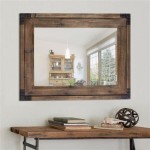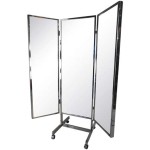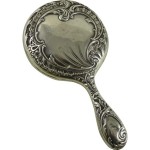How to Attach a Mirror to a Door
Attaching a mirror to a door presents a practical solution for spaces where wall real estate is limited. This modification allows for full-length reflection capabilities without sacrificing valuable living area. A variety of techniques and materials can be employed, each offering varying degrees of permanence and suitability depending on the mirror's size, weight, and the door's composition.
The success of this project hinges on careful planning, precise execution, and the selection of appropriate materials. Improper installation can result in a damaged mirror, a compromised door, or, worse, a safety hazard. This document outlines several established methods for securely attaching a mirror to a door, providing detailed steps and considerations for each approach.
Selecting the Right Method and Materials
The first step involves determining the best method for attaching the mirror. Several factors influence this decision, including the mirror’s size and weight, the door’s material (wood, hollow core, metal), and the desired level of permanence. Lighter mirrors can often be attached with adhesive methods, while heavier mirrors typically require mechanical fasteners for secure support.
For wooden doors, both adhesive and mechanical fastening options are viable. Hollow-core doors, however, necessitate careful consideration, as they offer limited structural support. Metal doors present another set of challenges, requiring specialized adhesives or drilling techniques.
The following materials are commonly used for mirror attachment:
*Mirror Adhesive:
Specifically formulated to bond mirrors to various surfaces. It provides a strong, permanent bond and prevents damage to the mirror's reflective backing. It is crucial to use a mirror-specific adhesive; standard construction adhesives can damage the mirror's silvering. *Double-Sided Mounting Tape:
Offers a temporary or semi-permanent attachment solution. Look for heavy-duty, moisture-resistant tapes designed for mounting mirrors. The tape's weight capacity should exceed the mirror's weight by a significant margin. *Mirror Clips:
Mechanical fasteners that secure the mirror along its edges. They provide a robust and visually appealing attachment method. Mirror clips are often used in conjunction with adhesive for added security, particularly for larger mirrors. *Screws and Anchors:
Used to attach mirror clips or mounting hardware directly to the door. The selection of appropriate screw length and anchor type is critical, especially for hollow-core or metal doors. *Safety Backing (Optional):
A film applied to the back of the mirror to prevent shattering in case of breakage. This is a highly recommended safety measure, particularly in high-traffic areas or homes with children or pets. *Level:
Essential for ensuring the mirror is installed straight and plumb. *Measuring Tape:
For accurate placement and marking of the mirror's position. *Pencil or Marker:
For marking the door and mirror. *Drill (Optional):
Required for installing mirror clips or anchors. *Safety Glasses:
To protect eyes from debris during drilling or cutting. *Gloves:
To protect hands and prevent fingerprints on the mirror surface.Adhesive Attachment Method
The adhesive attachment method is suitable for lighter mirrors and solid-core doors. However, proper surface preparation is crucial for ensuring a strong and lasting bond.
The first step is to thoroughly clean the door surface with a degreaser and a clean cloth. Remove any dust, dirt, or grease that could interfere with the adhesive's bonding ability. Allow the surface to dry completely before proceeding.
Next, apply the mirror adhesive to the back of the mirror in vertical beads, spaced several inches apart. Avoid applying adhesive to the edges of the mirror, as this can squeeze out and create a messy appearance. Alternatively, use double-sided mounting tape, applying it in a grid pattern across the back of the mirror. Ensure the tape covers a significant portion of the mirror's surface area to provide adequate support.
Carefully position the mirror on the door, using a level to ensure it is straight. Press firmly against the mirror surface for several minutes to allow the adhesive to make initial contact with the door. Support the mirror with temporary shims or bracing while the adhesive cures. Refer to the adhesive manufacturer's instructions for the recommended curing time, which is typically 24 to 48 hours.
After the adhesive has fully cured, remove the shims or bracing. The mirror should now be securely attached to the door. It is advisable to avoid slamming the door or applying excessive force to the mirror to prevent detachment.
For added security, consider using a combination of adhesive and double-sided tape. The tape provides immediate holding power while the adhesive cures, resulting in a stronger and more reliable bond.
Mechanical Fastening with Mirror Clips
Mechanical fastening with mirror clips is a more robust attachment method, suitable for heavier mirrors and doors that require a more secure installation. This method involves attaching clips to the door that hold the mirror in place.
Begin by determining the placement of the mirror clips. The clips should be positioned along the edges of the mirror, typically spaced 12 to 18 inches apart. Mark the location of each clip on the door, using a level to ensure they are aligned and evenly spaced.
Pre-drill pilot holes at the marked locations, using a drill bit that is slightly smaller than the diameter of the screws. For hollow-core doors, install wall anchors in the pilot holes to provide additional support. Select anchors that are appropriate for the door's material and the weight of the mirror.
Position the mirror clips over the pilot holes or anchors and secure them to the door with screws. Ensure the screws are tightened firmly, but avoid over-tightening, as this can damage the door or the clips. Some mirror clips are adjustable, allowing for fine-tuning of the mirror's position. Adjust the clips as needed to ensure the mirror is held securely and flush against the door.
Once all the clips are installed, carefully slide the mirror into place. The clips should grip the mirror's edges firmly, preventing it from moving or shifting. Double-check that the mirror is level and plumb before finalizing the installation.
This method provides a secure and visually appealing way to attach the mirror. Mirror clips are available in various styles and finishes, allowing them to blend seamlessly with the door's hardware and décor.
Addressing Hollow-Core Doors
Attaching a mirror to a hollow-core door presents unique challenges due to the door's limited structural integrity. Hollow-core doors consist of a thin veneer of wood or composite material over a hollow interior, making them unsuitable for supporting heavy loads.
When attaching a mirror to a hollow-core door, it is essential to minimize the weight of the mirror and to distribute the load evenly across the door's surface. Lightweight mirrors are preferable, and adhesive methods should be supplemented with mechanical fasteners for added security.
Use wall anchors specifically designed for hollow-core doors. These anchors expand or grip the interior of the door, providing a secure attachment point for screws or bolts. Follow the anchor manufacturer's instructions carefully when installing them, ensuring they are properly seated and can support the mirror's weight.
Consider using a thin sheet of plywood or hardboard behind the mirror to distribute the weight more evenly across the door's surface. Attach the plywood or hardboard to the door using construction adhesive and screws, ensuring it is securely bonded to both the door and the mirror. This will help to reinforce the door and prevent it from flexing or warping under the mirror's weight.
Regularly inspect the mirror's attachment to the hollow-core door to ensure it remains secure. Over time, the door may weaken or the fasteners may loosen, requiring periodic adjustments or repairs. Taking these precautions will help to ensure the mirror remains safely and securely attached to the hollow-core door.
No matter which method is chosen, it is always advisable to err on the side of caution and use more fasteners or adhesive than necessary. A securely attached mirror is not only aesthetically pleasing but also a safety requirement.

3 Ways To Hang A Door Mirror Wikihow

3 Ways To Hang A Door Mirror Wikihow

3 Ways To Hang A Door Mirror Wikihow

Framing Out A Mirror That S Mounted On Door Young House Love

Over The Door Hanging Mirrors A Comprehensive Guide

3 Ways To Hang A Door Mirror Wikihow

3 Ways To Hang A Door Mirror Wikihow

Framing Out A Mirror That S Mounted On Door Young House Love

Easily Mount A Door Mirror Without Hardware

Over The Door Hanging Mirrors A Comprehensive Guide








